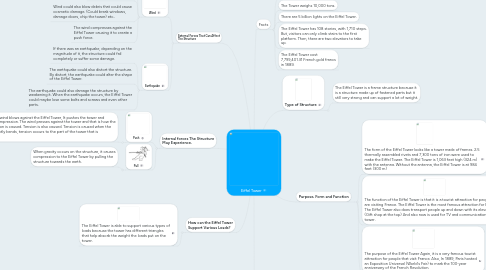Eiffel Tower
Door Japmin Chahal

1. External Forces That Can Affect The Structure
1.1. Wind
1.1.1. If the wind was strong enough , It could potentially damage the Eiffel Tower because of its force.
1.1.2. OVERTIME, Wind could weaken the Eiffel Tower.
1.1.3. Wind could also blow debris that could cause cosmetic damage. (Could break windows, damage doors, chip the tower) etc..
1.1.4. The wind compresses against the Eiffel Tower causing it to create a push force.
1.2. Earthquake
1.2.1. If there was an earthquake, depending on the magnitude of it, the structure could fail completely or suffer some damage.
1.2.2. The earthquake could also distort the structure. By distort, the earthquake could alter the shape of the Eiffel Tower.
1.2.3. The earthquake could also damage the structure by weakening it. When the earthquake occurs, the Eiffel Tower could maybe lose some bolts and screws and even other parts.
2. How can the Eiffel Tower Support Various Loads?
2.1. The Eiffel Tower is able to support various types of loads because the tower has different triangles that help absorb the weight the loads put on the tower.
3. Internal forces The Structure May Experience.
3.1. Push
3.1.1. When the wind blows against the Eiffel Tower, It pushes the tower and causes Compression. The wind presses against the tower and that is how the compression is caused. Tension is also caused. Tension is caused when the tower slightly bends, tension occurs to the part of the tower that is extended.
3.2. Pull
3.2.1. When gravity occurs on the structure, it causes compression to the Eiffel Tower by pulling the structure towards the earth.
4. Type of Structure
4.1. The Eiffel Tower is a frame structure because it is a structure made up of fastened parts but it still very strong and can support a lot of weight.
5. Purpose, Form and Function
5.1. The form of the Eiffel Tower looks like a tower made of frames. 2.5 thermally assembled rivets and 7,300 tons of iron were used to make the Eiffel Tower. The Eiffel Tower is 1,063 feet high (324 m) with the antenna. Without the antenna, the Eiffel Tower is at 984 feet (300 m)
5.2. The function of the Eiffel Tower is that it is a tourist attraction for people that are visiting France. The Eiffel Tower is the most famous attraction for France. The Eiffel Tower also does transport people up and down with its elevator. (Gift shop at the top) And also now is used for TV and communications tower.
5.3. The purpose of the Eiffel Tower Again, it is a very famous tourist attraction for people that visit France. Also, In 1889, Paris hosted an Exposition Universal (World's Fair) to mark the 100-year anniversary of the French Revolution.
6. Centre of Gravity
6.1. The COG on the Eiffel Tower is near the bottom because of its wide base. This is important because the Eiffel Tower is very tall and it uses the width of the base and low COG to keep it upright.
7. Facts
7.1. The Eiffel Tower was the tallest man made structure until the Chrysler Building was built in New York in 1930.
7.2. The Tower weighs 10,000 tons.
7.3. There are 5 billion lights on the Eiffel Tower.
7.4. The Eiffel Tower has 108 stories, with 1,710 steps. But, visitors can only climb stairs to the first platform. Then, there are two elevators to take up.
7.5. The Eiffel Tower cost 7,799,401.31 French gold francs in 1889.


